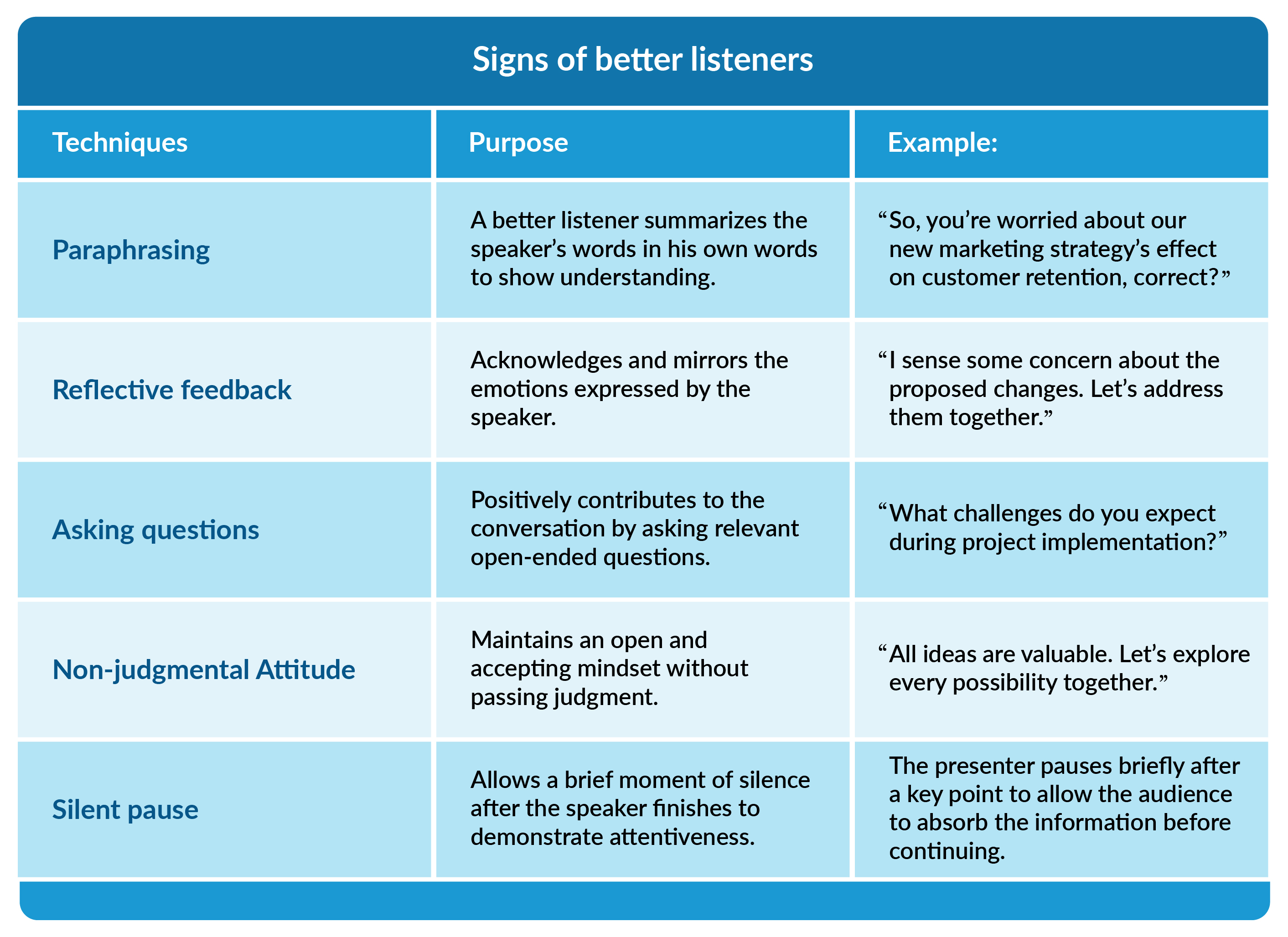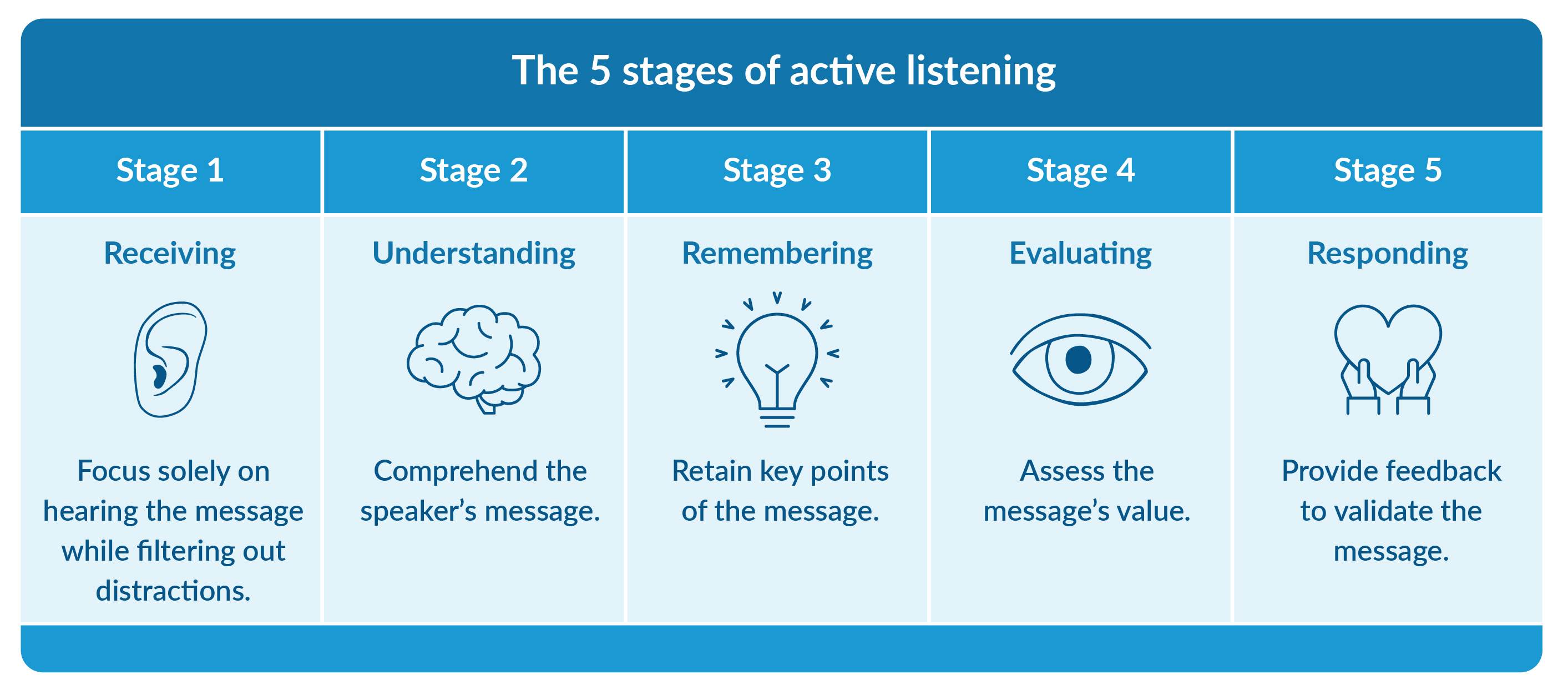Engage your audience: The secret weapon of active listening in presentations

Captivating an audience goes beyond just delivering information with words. It's about fostering a genuine connection that resonates with each of your audiences. Active listening is a skill that transforms a presenter from a mere conveyor of content into a powerful communicator capable of captivating, engaging, and actively listening to their audience on a profound level, without interrupting their flow.
In this article, we will learn about the transformative power of active listening and explore how this fundamental skill enhances the presenter's ability to connect and communicate effectively with the audience. Additionally, we will examine some common barriers to active listening that we often inadvertently encounter.
What is active listening and why is it important?
Communication, in its essence, is a two-way street. It involves not just speaking, but also active listening. The latter is often overlooked, which leads to ineffective communication. Active listening is the art of fully engaging with what others are saying. It is not merely a passive act of hearing words but a dynamic process that fosters understanding and connection.
In both personal and professional spheres, the ability to actively listen not only fosters understanding but also nurtures relationships, mitigates misunderstandings, and facilitates effective problem-solving.
Here are 4 key reasons why active listening is important in a presentation:
1. Building audience engagement: Active listening during a presentation builds a sense of connection and rapport between the presenter and the audience. By demonstrating genuine interest and attention to their responses, presenters can cultivate trust and rapport, leading to a more engaged and receptive audience.
2. Creating emotional impact: Engaging in active listening enables presenters to not only grasp the words being spoken but also to recognize the underlying emotions and sentiments of the audience. This emotional connection allows presenters to tailor their message to resonate with the feelings and concerns of their listeners, resulting in a more impactful and memorable presentation experience.
3. Adapting to audience dynamics: Through active listening, presenters remain attuned to the diverse perspectives and reactions of their audience members. By understanding the viewpoints and needs of their listeners, presenters can adapt their delivery style, content, and pace to ensure maximum resonance and relevance, thereby enhancing audience satisfaction and understanding.
4. Minimizing miscommunication: Effective communication centers on the ability to actively listen and respond appropriately. By actively engaging in the listening process during presentations, presenters can clarify information, address audience questions or concerns in real-time, and ensure that messages are accurately interpreted. This in turn minimizes the risk of errors and misunderstandings that can detract from the effectiveness of the presentation.
Tune in to this podcast to grasp how listening with the intent to understand can boost your communication skills and guide you through navigating changes effectively.
What are the effective active listening techniques?
Effective active listening techniques empower individuals to fully engage with what speaker is saying, understand their perspectives, and reply thoughtfully. These techniques are essential tools for enhancing communication and fostering meaningful connections.
Let's explore some simple yet powerful techniques that can help you develop your active listening skills. These techniques are useful for improving communication effectiveness and deepening understanding.
1. Make eye contact: Establishing and maintaining eye contact conveys attentiveness and interest, signaling to the speaker that their words are being valued and respected.
2. Provide verbal and non-verbal feedback: Research indicates that a significant portion, ranging from 70% to 93% of all communication is conveyed through nonverbal cues. Encourage the speaker through affirmative nods, verbal affirmations such as "I understand," and appropriate facial expressions, demonstrating engagement and understanding. Verbalizing the emotions will help the speaker to evaluate their feelings and provide clarity.
3. Paraphrase: Reflect on what has been said by paraphrasing key points. This not only confirms understanding and interest but also validates the speaker's contributions.
4. Ask questions: Seek clarification on unclear points to ensure a better understanding of the message being shared with you. Asking open-ended questions will provide you with more information in the context of your presentation. Asking questions demonstrates active involvement in the conversation and a genuine interest in understanding the speaker's perspective.
5. Summarize: Summarizing the conversation with the key points of the discussion will help you put together the important ideas that were discussed. Apart from providing clarity to the speaker, it also establishes a basis for further discussion.
6. Be patient: Being patient is very important in active listening. This allows the speaker to finish what he/she wants to convey without interruption or the need to finish the sentence. When you exhibit patience, you are also communicating that you are listening to understand and not responding.
7. Be non-judgmental: A neutral and non-judgmental response makes the speaker comfortable and gives them the confidence to speak without fear of being judged or criticized.

What are some common barriers to active listening?
Even though active listening holds great importance, it can face barriers beyond physical and environmental factors. These barriers, unique to each individual, mostly arise from our behaviors, mental barriers, and biases.
a) Preoccupation: Research indicates that while people speak at a rate of 125 to 175 words per minute, our minds can process between 400 and 800 words per minute. This gap between speech and thought rates enables us to simultaneously process numerous thoughts, potentially leading to mental distractions and preoccupations. Such distractions can hinder one's ability to fully engage in the listening process, resulting in misunderstandings and misinterpretations.
b) Selective listening: Focusing solely on certain aspects of the conversation while ignoring others can impede understanding and compromise the effectiveness of communication exchanges.
c) Judgment and bias: Preconceived notions, biases, and judgments can cloud one's ability to objectively listen and comprehend the speaker's message, leading to misinterpretations and conflicts.
d) Defensiveness: Feeling defensive or threatened during a conversation can inhibit active listening, as individuals may be more focused on formulating their responses rather than genuinely understanding the speaker's perspective.
What are the 5 stages of active listening?
Active listening is a foundational skill in effective communication, enabling individuals to fully engage with speakers and understand their messages. To understand the complexities of active listening, it's essential to break down the process into its five distinct stages.
Let's explore the five stages of active listening with examples and understand how they contribute to enhancing communication effectiveness.
Stage 1: Receiving
At this stage, your ears take center stage as you focus solely on hearing the message while filtering out other sources of stimuli. It's essential to isolate the message to avoid confusion.
Example: As a presenter, you start your presentation by ensuring that your audience can clearly hear you. You adjust the microphone and speak clearly, allowing them to focus solely on your message without distractions.
Stage 2: Understanding
Effective listening goes beyond hearing words; it requires comprehending the speaker's intended message. However, individual backgrounds and experiences can lead to misinterpretations. Recognizing and addressing differences between perceptions ensures accurate comprehension.
Example: Throughout your presentation, you gauge the audience's reactions to ensure they understand the concepts. You pause to ask if they have any questions, allowing for clarification and ensuring everyone is on the same page.
Stage 3: Remembering
Remembering what was said is crucial for effective listening. Complex messages demand developed listening skills, and even brief distractions can lead to missed information. Meaningful processing improves memory retention, ensuring accurate recollection.
Example: You use visuals, anecdotes, and repetition to help the audience remember the key points of your presentation. You reinforce important ideas and provide handouts or slides for them to reference later.
Stage 4: Evaluating
Evaluating is the fourth stage, where listeners analyze the message's value based on biases and perspectives. Clarity, logic, and supporting reasons influence evaluation. Avoiding biased judgments is essential for understanding the speaker's intended meanings.
Example: After presenting each section, you encourage the audience to reflect on the material. You ask for feedback through polls or surveys to evaluate their understanding and gather insights for improvement.
Stage 5: Responding
Responding, or providing feedback, is the final stage. It’s about validating the speaker’s message. Actions taken here indicate involvement and contribute to effective communication, allowing for interaction and clarification between speakers and listeners.
Example: You actively engage with the audience during Q&A sessions, responding thoughtfully to their questions and concerns. You validate their input, acknowledging their contributions and fostering a collaborative environment.

How to integrate Active Listening in PowerPoint presentations?
Practicing active listening is crucial, but how can you integrate it into your presentation effectively?
When creating your slide ppt presentation, align it with the five stages of active listening and consider your audience as active participants. Aim for PowerPoint slides that are clear, concise, and impactful, effectively delivering information.
Slide 1 (Receiving): Clear communication
Use a clear font and avoid clutter to ensure the message is easily received by the audience. Minimize distractions on the slide to allow the message to shine through clearly.
Slide 2 (Understanding): Visual understanding
Incorporate visuals that resonate with the audience and help decode complex information. Utilize diagrams, illustrations, or graphs to simplify concepts and aid in understanding.
Slide 3 (Remembering): Memorable impressions
Include a memorable quote or impactful image that leaves an imprint on the audience's memory. This visual element serves as a focal point and reinforces key points for better retention.
Slide 4 (Evaluating): Elegant Evaluation
Present data and information elegantly using charts, graphs, or infographics. Use compelling facts and figures to influence the audience's opinions and encourage critical evaluation.
Slide 5 (Responding): Call to Action
Conclude the presentation with a call to action, inviting the audience to reflect on the message or take specific steps. Encourage applause for engagement or reflection for deeper understanding.
How to handle challenging questions in Q&A sessions using active listening?
Navigating challenging questions during Q&A sessions requires clever communication skills, with active listening playing a pivotal role in the process. Here's how to effectively handle such situations:
Remain calm and composed: Maintain a calm and composed demeanor when faced with challenging questions to demonstrate confidence and professionalism.
Listen actively: Paying attention to the question being asked, focusing on the speaker's words, tone, and body language to fully understand their concerns or inquiries.
Acknowledge and validate: Acknowledge the questioner's perspective and validate their concerns, even if you may not necessarily agree with them. This demonstrates respect and empathy, fostering a constructive dialogue.
Paraphrase for clarity: Paraphrase the question to ensure mutual understanding and clarity, confirming that you have correctly interpreted the speaker's inquiry.
Respond thoughtfully: Provide a thoughtful and well-articulated response, addressing the question directly while also considering the broader context and implications. Avoid rushing to answer the question and take the time to formulate a structured response.
Elon Musk's response serves as the best example of well-articulated reasoning. When questioned about the feasibility of economically constructing tunnels in LA, Musk showcased thoughtful and logical reasoning.
Encourage discussion: Encouraging further discussion and clarification will also help if needed, inviting additional questions or feedback to ensure that all concerns are addressed satisfactorily.
Key takeaways for active listeners:
• Active listening is a fundamental skill in effective communication, enabling presenters to fully engage with their audience and understand their messages.
• By actively listening, presenters can create emotional impact, adapt to audience dynamics, minimize miscommunication, and build trust. Genuine connections and rapport between presenters and audiences lead to increased engagement and receptiveness.
• Effective active listening techniques include maintaining eye contact, providing verbal and non-verbal feedback, paraphrasing, asking questions, summarizing, being patient, and maintaining a non-judgmental attitude.
• Common barriers to active listening include preoccupation, selective listening, judgment and bias, and defensiveness.
• The five stages of active listening are receiving, understanding, remembering, evaluating, and responding, each contributing to enhancing communication effectiveness.
• Integrating active listening into PowerPoint presentations involves aligning slides with the five stages, ensuring clarity, utilizing compelling visuals, including memorable elements, presenting data elegantly, and concluding with a call to action.
• Challenging quiz in Q&A sessions can be handled easily with active listening.
How does Prezent support active listening in presentations?
Prezent provides presenters with the tools they need to foster active listening and ensure impactful communication during presentations. It excels in integrating active listening into presentations through several key features:
Structured storylines: Prezent offers tools for crafting clear and structured communication, enabling presenters to organize their content logically and guide the audience through a coherent narrative. By providing templates and frameworks, Prezent helps users construct engaging storylines that facilitate active listening and comprehension.
Compelling visuals: With Prezent, presenters can easily incorporate compelling visuals such as diagrams, illustrations, and infographics to simplify complex information and enhance memory retention. Effective data charts and graphs enable audiences to evaluate information quickly and make informed decisions.
Synthesis: Prezent enables users to create executive summaries efficiently, synthesizing key points and insights from their presentations. This feature facilitates audience guidance by providing a concise overview of the main ideas and recommendations, enhancing active listening and understanding.
Learn more about Prezent’s capabilities and functions by scheduling a demo at your convenience or explore the platform yourself by using your free trial today!



.avif)








